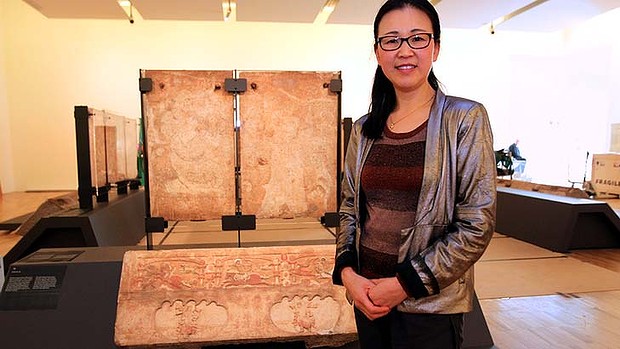RR Phantom

Location : Wasted Space
Job/hobbies : Cayman Islands Actuary
 |  Subject: Tales from the crypt: sarcophagus lifts lid on sixth century life Subject: Tales from the crypt: sarcophagus lifts lid on sixth century life  Tue Aug 20, 2013 12:03 am Tue Aug 20, 2013 12:03 am | |
| It was common for elites in sixth-century China to be buried in a sarcophagus that resembles a Chinese house, like the centrepiece of A Silk Road Saga, a new exhibition opening at the Art Gallery of NSW on Thursday.

However, the richly detailed, white marble tomb of central Asian diplomat Yu Hong and his wife is a rarity, says curator Cao Yin.
Its carvings and designs contain no Chinese elements at all.
'The most unique thing about this discovery is the carvings and the motifs,'' says Cao, the gallery's curator of Chinese art. ''There are no dragons, no mythical cloud, which is seen on traditional Chinese art. It's full of Persian, central Asian and Buddhist influences.''
Advertisement
The human figures in its 13 panels are Turkish, central Asian and Persian in appearance. No one is Chinese.
It is believed Hong came from a community of Turkic speakers in central Asia. He would have travelled along the Silk Road and undertook his first diplomatic mission as a 13-year-old to Persia, where he stayed for four or five years.
He was then sent to China's Northern Qi dynasty, whose power base was in Taiyuan, an area that was more open and Westernised than other parts of China. There he worked as a government official in charge of the contemporary equivalent of foreign affairs, Cao says.
An image of Yu and his wife, who were interred in AD592 and AD598 respectively, bears Persian and Buddhist influences. They are seen raising a toast to each other.
Other scenes depict a dancer from central Asia surrounded by musicians, wine-making and hunting.
Animals depicted, both carved and painted, include camels, birds, elephants, 15 lions and lots of little dogs - looked upon favourably in Zoroastrianism - as well as a merhorse (half horse, half mermaid).
There is also a Zoroastrian image of two priests - half man, half bird - worshipping fire.
Nearly 1400 years since its creation, traces of the gold and red mineral pigments used to decorate the scenery and details of fabric patterns on clothing remain visible.
The sarcophagus was originally in the shape of a traditional Chinese house but, in the exhibition, the panels - each weighing about 200 kilograms and requiring a forklift for their installation - are displayed separately, so that visitors can walk around and between them.
Nearly 20 objects excavated from the tomb - which was looted numerous times - or burials from the same period are also on display.
The imagery not only presents a snapshot of Yu and his wife, their status and the time in which they lived, the sarcophagus also bears the scar of its discovery in Taiyuan in 1999.
A small dent was made when the farmer who uncovered it struck its roof with a shovel while repairing a road.
It could have been worse. Four years earlier, a water pipe was laid nearby, missing the tomb by less than a metre.
The exhibition, a collaboration with the Shanxi Museum, was initiated by former Art Gallery of NSW director Edmund Capon, who first encountered the sarcophagus in a police station in Taiyuan and who will address a symposium on the exhibition on Saturday.
''I want people to understand that, in the sixth century, China was laying a foundation for the great Tang Dynasty (AD618 to AD907),'' Cao says.
''Without this multicultural integration and new ideas, there would not have been the flourishing Tang Dynasty.
''It's almost like China now. Very open to the West. There are [now] lots of Yu Hongs going back and forth, doing business, bringing prosperity not only to China but also to the West.''
A Silk Road Saga runs from Thursday until November 10.
|
|

